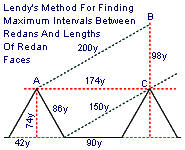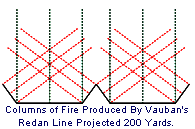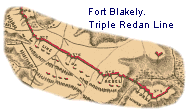Development of redan lines was traditionally attributed to the
great French engineer Vauban who employed a series of redans connected by
curtains laid out on right lines as the basic pattern for lines of
circumvallation that protected the camps and depots of a besieging army from
enemy forces attempting to relieve a besieged fortification. This pattern
was adapted to general lines constructed for the purpose of closing extended
stretches of ground; many of the lines constructed by the French during the
early eighteen century wars in
 Europe to close their frontiers or protect fertile country from
hostile foraging were laid out as redan lines. When laid out on a level site
Vauban's redan line spaced redans about 200 yards apart (from capital to
capital of the line's redans) with the capital of each redan about 40 yards
long. Gorges of the redans were about 60 yards on the general line of the
curtain and the curtain was about 170 yards long. Passages through the curtains
were covered by lunettes laid out as the redans, but with their faces cut
off at a distance of 36 yards from the capital to form flanks which were
terminated about 10 yards from the line of the curtain. Angles in a redan
line could also be covered by small bastions with faces about 50 yards long,
capitals 50 yards taken from the salient of the bastion to the Europe to close their frontiers or protect fertile country from
hostile foraging were laid out as redan lines. When laid out on a level site
Vauban's redan line spaced redans about 200 yards apart (from capital to
capital of the line's redans) with the capital of each redan about 40 yards
long. Gorges of the redans were about 60 yards on the general line of the
curtain and the curtain was about 170 yards long. Passages through the curtains
were covered by lunettes laid out as the redans, but with their faces cut
off at a distance of 36 yards from the capital to form flanks which were
terminated about 10 yards from the line of the curtain. Angles in a redan
line could also be covered by small bastions with faces about 50 yards long,
capitals 50 yards taken from the salient of the bastion to the
 angle formed by prolongations of the curtains, and flanks 20
yards long. angle formed by prolongations of the curtains, and flanks 20
yards long.
Most pre-Civil War period manuals maintained Vauban's dimensions
for redan lines while suggesting only very minor adjustments. J. S. Macaulay
described redan lines as having redans 260 yards apart with 30 yards of
demi-gorge and capitals 44 yards long. He suggested that the redans be positioned
at 200 yards (rather than 260) intervals to bring the prolongation of the
redan capitals within musket range of collateral redan faces. D. H. Mahan
described a redan line that had the redan capitals 180 yards apart, redan
faces 60 yards long and
 salients opened 60°, which gave a distance of 160 yards
from redan salients to collateral re-enterings where redan faces joined the
straight curtains. Rather than setting down an exact distance between salients
in redan lines A. F. Lendy described a method that could be used to insure
that ground in front of each redan salient was well protected by fire delivered
from the faces of collateral redans. This method took a line perpendicular
to the face of a redan and projected from the salient angle of the redan
to the maximum effective range of the small arms that salients opened 60°, which gave a distance of 160 yards
from redan salients to collateral re-enterings where redan faces joined the
straight curtains. Rather than setting down an exact distance between salients
in redan lines A. F. Lendy described a method that could be used to insure
that ground in front of each redan salient was well protected by fire delivered
from the faces of collateral redans. This method took a line perpendicular
to the face of a redan and projected from the salient angle of the redan
to the maximum effective range of the small arms that
 would be used to defend the line. From that point exterior
to the line a second line was projected perpendicular to the general line
of the curtain to mark the capital of a second redan. This insured that fire
from each face was strike ground along the weakest point of the redan, that
is, along the prolongations of the redans' capitals. would be used to defend the line. From that point exterior
to the line a second line was projected perpendicular to the general line
of the curtain to mark the capital of a second redan. This insured that fire
from each face was strike ground along the weakest point of the redan, that
is, along the prolongations of the redans' capitals.
Redan lines were considered to have a relatively great number
of defects that limited their usefulness: the ditches were not flanked and
could not be seen from the interior crest; the faces of the redans were protected
by a very oblique (and therefore less certain) fire delivered from the curtains;
salients of the redans produced large sectors without fire that were not
completely defended by fire from collateral redans. Faces of the redans crossed
their fire with that of the curtain at a distance from the curtain and could
not participate in the close defense of the curtains. Once an attacking body
of troops reached the ditch it could not
 be reached by fire delivered from the parapet while ground in
front of the ditch was not adequately protected by over-lapping or crossing
columns of fire. The greatest concentration of fire was projected over ground
in front of the curtains while the most vulnerable points of attack, the
redan salients, were protected by the least amount of fire delivered at the
longest ranges from the parapet. Many manuals suggested that these defects
could be partially mitigated by breaking the curtains forward to form two
faces that could better project columns of fire across the redan faces and
salients, but. this modification in the trace converted redan lines into
tenaille lines, a distinct type of line that must be treated separately. be reached by fire delivered from the parapet while ground in
front of the ditch was not adequately protected by over-lapping or crossing
columns of fire. The greatest concentration of fire was projected over ground
in front of the curtains while the most vulnerable points of attack, the
redan salients, were protected by the least amount of fire delivered at the
longest ranges from the parapet. Many manuals suggested that these defects
could be partially mitigated by breaking the curtains forward to form two
faces that could better project columns of fire across the redan faces and
salients, but. this modification in the trace converted redan lines into
tenaille lines, a distinct type of line that must be treated separately.
As with all temporary fortifications, redan lines that were actually
constructed tended to deviate from the basic prescribed pattern and dimensions
in proportion to the irregularity of the ground where they were sited
 influenced, as a matter of course, by the skill of the engineer
charged with their design along with the time, material resources, and labor
at his disposal. For instance, much of the original entrenched line constructed
in influenced, as a matter of course, by the skill of the engineer
charged with their design along with the time, material resources, and labor
at his disposal. For instance, much of the original entrenched line constructed
in
 1862 by Captain Charles F. Liernur to protect Mobile, Alabama
was laid out as a regular redan line on ground that was very nearly level
and did not require any extreme deviations from the basic prescribed pattern.
The same held true for the fortifications hastily constructed to cover
Montgomery, Alabama, though here the ground was not level, rather, the line
was laid out to follow distinct ridge lines and was adjusted, both by adapting
the basic redan traces and the uniformity of their intervals, to suit
irregularities of the ground. An 1862 by Captain Charles F. Liernur to protect Mobile, Alabama
was laid out as a regular redan line on ground that was very nearly level
and did not require any extreme deviations from the basic prescribed pattern.
The same held true for the fortifications hastily constructed to cover
Montgomery, Alabama, though here the ground was not level, rather, the line
was laid out to follow distinct ridge lines and was adjusted, both by adapting
the basic redan traces and the uniformity of their intervals, to suit
irregularities of the ground. An
 extreme case is provided by the Confederate line laid out by
Confederate Colonel Samuel H. Lockett to cover Vicksburg, Mississippi. Lockett's
line followed a series of ridges surrounding the town that were marked by
irregular spurs interspaced with deep ravines; Lockett applied irregular
redans and lunettes with strong profiles to the advanced points of the ridges
and connected them with lines of rifle trenches laid out to command the ridges'
slopes and create re-entering angles in the general line that covered the
heads of ravines falling away extreme case is provided by the Confederate line laid out by
Confederate Colonel Samuel H. Lockett to cover Vicksburg, Mississippi. Lockett's
line followed a series of ridges surrounding the town that were marked by
irregular spurs interspaced with deep ravines; Lockett applied irregular
redans and lunettes with strong profiles to the advanced points of the ridges
and connected them with lines of rifle trenches laid out to command the ridges'
slopes and create re-entering angles in the general line that covered the
heads of ravines falling away
 from the ridges. Yet another deviation is found in the Confederate
line composing Fort Blakely, Alabama where the Confederate engineers employed
a series of irregular triple redans to fortify commanding points along the
line while connecting them with relatively straight stretches of continuous
parapet. from the ridges. Yet another deviation is found in the Confederate
line composing Fort Blakely, Alabama where the Confederate engineers employed
a series of irregular triple redans to fortify commanding points along the
line while connecting them with relatively straight stretches of continuous
parapet. |